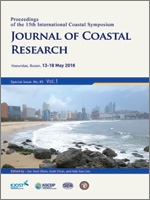Herkül, K.; Aps, R.; Lokko, K.; Peterson, A., and Tõnisson, H., 2018. Relating Coastal Geomorphology to Marine Benthic Biodiversity. In: Shim, J.-S.; Chun, I., and Lim, H.S. (eds.), Proceedings from the International Coastal Symposium (ICS) 2018 (Busan, Republic of Korea). Journal of Coastal Research, Special Issue No. 85, pp. 366–370. Coconut Creek (Florida), ISSN 0749-0208.
Coastal geomorphology determines the essential environmental characteristics, such as substrate type and stability, terrestrial water regime and underwater hydrodynamics, that form the basic abiotic settings for the biota. While the importance of coastal geomorphology in determining the patterns of biological communities is relatively well studied on the terrestrial side of the shoreline, the respective relationships have been rarely studied seaward from the shoreline. Therefore, we aimed to fill this research gap by relating coastal geomorphology to marine benthic biodiversity. We studied the variability of species richness of macroscopic seabed fauna and flora along different shore geomorphic types in the Gulf of Finland, Baltic Sea. The shore was classified into nine geomorphological types. Spatial buffers of sizes 125–1000 m (hereafter “scales”) were formed around each segment of shoreline and mean values of faunal, floral, and total species richness were calculated in each segment and scale. ANOVA revealed that biodiversity significantly differed between the shore types. Generally, the biodiversity was the highest among the types “Scraps and steep slopes in sand”, “Exposed rocky cliffs with boulder talus base” and “Sheltered rocky rubble shores” and the lowest among the type “Exposed, solid man-made structures”. Smaller spatial scales hosted higher biodiversity but the interaction between shore type and scale was not statistically significant. To conclude, the coastal geomorphology reflects the general patterns of underwater biodiversity, and thus, the information of shore geomorphic types can be used in coastal management and oil pollution combating prioritization in the case when the information of underwater biota is not available.





